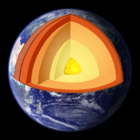Difference between revisions of "Material/Twenty most abundant elements in Earth's crust"
From AdCiv
< Material
| Line 2: | Line 2: | ||
[[Image:Pariah canyon.jpg|140px|right|Earth's crust]] | [[Image:Pariah canyon.jpg|140px|right|Earth's crust]] | ||
| + | [[Image:Earth.png|140px|right|Earth cutaway]] | ||
{| | {| | ||
! style="background:#E5E5E5;" width="150px" align="left" | Element !! style="background:#E5E5E5;" width="80px" align="right" | % mass | ! style="background:#E5E5E5;" width="150px" align="left" | Element !! style="background:#E5E5E5;" width="80px" align="right" | % mass | ||
Revision as of 22:38, 7 February 2009
Approx figures for the 20 most abundant elements in Earth's crust:
| Element | % mass |
|---|---|
| Oxygen | 46.71 |
| Silicon | 27.69 |
| Aluminum | 8.07 |
| Iron | 5.05 |
| Calcium | 3.65 |
| Sodium | 2.75 |
| Potassium | 2.58 |
| Magnesium | 2.08 |
| Titanium | 0.62 |
| Hydrogen | 0.14 |
| Phosphorus | 0.13 |
| Carbon | 0.09 |
| Manganese | 0.09 |
| Sulfur | 0.05 |
| Barium | 0.05 |
| Chlorine | 0.05 |
| Chromium | 0.04 |
| Fluorine | 0.03 |
| Zirconium | 0.03 |
| Nickel | 0.02 |
Figures from [1]
Figures rounded to two decimal places
Also need to have a list based on ease of extraction and energy required
Notable missing from top 20:
- Copper.
Carbon might replace copper for many electrical conduction applications, and in the right form has the potential to be an even more efficient conductor - see carbon nanotube

